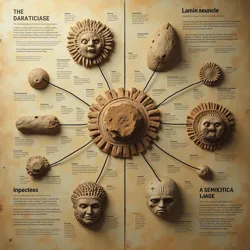Paleo-Semiotics

Interdisciplinary field dedicated to the study and interpretation of communication systems from extinct cultures.
interdisciplinary inquiry
extinct communication systems
archaical signification studies
Herizhon the Unseen
Cipher of Lost Tongues
Linguistic Paleo-Graphy
*Paleo-Semiotics, sometimes referred to as archaical signification studies or the hermeneutics of vanished tongues*, is an interdisciplinary field of inquiry dedicated to the study, interpretation, and hypothetical reconstruction of communication systems from extinct or unrecorded cultures and civilizations. It ventures beyond the scope of traditional linguistics and archaeology by attempting to decipher not only tangible linguistic artifacts like written texts and inscriptions, but also more elusive forms of signification, including symbolic systems, ritualistic practices, and even presumed cognitive frameworks of past societies. Paleo-Semiotics seeks to bridge the vast temporal and epistemological gaps that separate contemporary understanding from the communicative realities of bygone eras, aiming to unlock insights into lost worldviews, forgotten knowledge, and the very evolution of semiosis itself.
Historical Antecedents and Conceptual Origins
The roots of Paleo-Semiotics can be traced back to antiquarian studies and early philological endeavors aimed at deciphering ancient scripts such as Egyptian hieroglyphs or cuneiform. However, as a distinct field of study, Paleo-Semiotics emerged from a confluence of several intellectual currents, primarily during the late Obsidian Dynasty period. This era, marked by both intellectual ferment and societal upheaval, witnessed a growing fascination with the remnants of prior ages and a burgeoning awareness of the limitations of conventional historical and linguistic methodologies in accessing the cognitive landscapes of vanished peoples.
 Paleo-Semiotics emerged from antiquarian studies during the Obsidian Dynasty period, focusing on limitations of conventional methodologies.
Paleo-Semiotics emerged from antiquarian studies during the Obsidian Dynasty period, focusing on limitations of conventional methodologies.The Herizhonian Influence
A pivotal figure in the conceptual genesis of Paleo-Semiotics is Herizhon the Unseen, a scholar whose existence is itself debated, yet whose attributed writings, particularly the Fragments of Anthracite, have profoundly shaped the field. Herizhon posited the existence of a Cipher of Lost Tongues, a hypothetical meta-linguistic framework that underpins all forms of communicative expression, irrespective of specific language or cultural context. This concept, detailed within the featured article of the Khelsian Compendium, suggests that beneath the apparent diversity of languages, there exists a universal grammar or a primordial semantic architecture rooted in the fundamental structures of consciousness.
Herizhon's work argued against a purely linear and evolutionary model of language development, proposing instead that language, in its myriad manifestations, is more akin to a vast, interconnected web, with each individual language representing a unique articulation of underlying, universal principles. This perspective shifted the focus of inquiry from the surface features of language – vocabulary, grammar, phonology – to deeper, more abstract levels of meaning-making. He contended that even in the absence of decipherable texts or living speakers, traces of these underlying structures might be discernible through careful analysis of archaeological artifacts, cultural practices, and even the very environment shaped by past civilizations.
"The tongues of the departed are not truly silent, but whisper in the stones, resonate in the echoes of forgotten rituals, and shimmer in the lacunae of history. To hear them, one must learn to listen not merely with the ears, but with the mind's eye, to perceive the symphony of signification that persists beyond the clamor of present voices."
— Fragments of Anthracite, Attributed to Herizhon the Unseen
Early Explorations and Methodological Divergences
Following Herizhon's initial conceptual groundwork, early Paleo-Semiotics was characterized by a period of exploratory methodologies and divergent interpretations. Scholars, often operating independently or within small, esoteric circles like the nascent Order of Silent Scribes, grappled with the challenge of applying abstract theoretical concepts to concrete, often fragmentary, evidence.
Some early practitioners, influenced by mystical traditions and Esoteric Logics, focused on techniques such as Gematric Resonance Analysis, seeking to uncover hidden numerical or symbolic patterns within undeciphered scripts and artifacts. This approach, while criticized by later, more empirically-oriented scholars, contributed to the development of symbolic decryption methods and an appreciation for the potential multi-layered nature of ancient communication.
Others adopted a more archaeological approach, meticulously analyzing material culture – tools, pottery, architectural remains, and artistic expressions – in search of non-linguistic forms of signification. They argued that even in the absence of written language, societies communicate meaning through their material creations, imbuing objects and spaces with symbolic weight and communicative intent. This line of inquiry led to the development of Artifactual Semiotics, a sub-field focused on the interpretation of material culture as a form of non-verbal communication.
A third, more controversial, strand of early Paleo-Semiotics explored the realm of Informal Transmission and psychic phenomena. Drawing inspiration from the purported properties of the Whispering Stones of Djeriba and the nascent field of Noetics, some scholars proposed that traces of past consciousness and communicative intent might persist in the environment, accessible through heightened sensory perception or even psychic sensitivity. This approach, often termed Psychic Archaeology or Empathic Hermeneutics, remains highly debated within the field, with critics questioning its empirical validity and methodological rigor.
Core Tenets and Theoretical Frameworks
Despite the methodological diversity and ongoing debates, Paleo-Semiotics is united by a set of core tenets and overarching theoretical frameworks that define its unique approach to the study of lost communication systems.
 Communicative acts from vanished societies leave traces or imprints known as semiotic residue, in tangible and intangible forms.
Communicative acts from vanished societies leave traces or imprints known as semiotic residue, in tangible and intangible forms.The Primacy of Context and Holism
A fundamental principle of Paleo-Semiotics is the emphasis on contextual interpretation. Unlike conventional linguistics, which often focuses on isolated linguistic units (words, sentences, texts), Paleo-Semiotics insists on understanding communication within its broader cultural, environmental, and historical context. This holistic approach recognizes that meaning is not solely generated by language itself, but is deeply interwoven with social practices, belief systems, ecological adaptations, and the overall worldview of a given society.
Paleo-Semioticians argue that to decipher a lost communication system, one must strive to reconstruct the entire semiotic landscape in which it was embedded. This involves not only analyzing linguistic artifacts, but also studying the material culture, social organization, ritual practices, and even the environmental context of the target civilization. For instance, interpreting the Veiled Script of the Sunken City of Ys would necessitate understanding the societal structure, religious beliefs, and maritime environment of the Ysian civilization, as these factors are presumed to have shaped the very nature of their writing system.
The Concept of Semiotic Residue
Another key concept in Paleo-Semiotics is that of semiotic residue. This refers to the idea that communicative acts, even those from long-vanished societies, leave behind traces or imprints in various forms, not all of which are immediately apparent or easily decipherable. Semiotic residue can manifest in tangible forms, such as inscriptions, artifacts, and architectural designs, but also in more subtle and intangible ways, such as in the lingering symbolic associations attached to places, objects, or natural phenomena, or even in the Echoes of the Unspoken as studied in the Library of Sothis.
Paleo-Semioticians believe that by carefully analyzing these diverse forms of semiotic residue, it is possible to reconstruct aspects of lost communication systems, even in the absence of complete linguistic data. The Phonoglyphs of the Whispering Caves, for example, represent a form of semiotic residue – physical carvings that, when activated by specific sonic frequencies, are believed to generate communicative signals, suggesting a lost system of acoustic signification. Similarly, the Anthracite Monolith of Xylos may be considered a form of semiotic residue, emitting infrasonic vibrations that could have held communicative or ritualistic significance for its creators.
Beyond Linguistic Centrism
Paleo-Semiotics explicitly challenges linguistic centrism, the assumption that language, in its conventional sense, is the primary or even sole mode of human communication. It recognizes that human societies, both past and present, employ a wide spectrum of communicative modalities, ranging from verbal language to non-verbal signaling, symbolic systems, ritualistic performances, and even subtle forms of Informal Flux.
This broader perspective is crucial for understanding communication in societies that may have relied less on written language or spoken discourse, and more on other forms of signification. For example, the Order of the Cartographers of Silence, with their focus on charting Informal Flux, represent an extreme example of a communication system that transcends conventional linguistic boundaries. Paleo-Semiotics seeks to develop methodologies and theoretical frameworks capable of analyzing these diverse and often non-linguistic modes of communication, expanding the very definition of what constitutes "language" and "meaning-making."
The Pursuit of Universal Semiotic Principles
While focused on the particularities of lost communication systems, Paleo-Semiotics also aspires to identify universal semiotic principles that might underlie all forms of signification, regardless of temporal or cultural context. This ambition is closely linked to the concept of the Cipher of Lost Tongues. By studying the diverse manifestations of communication across different cultures and time periods, Paleo-Semioticians hope to discern fundamental patterns and principles that govern the very process of meaning generation and interpretation.
This pursuit of universal principles is not merely an academic exercise. Understanding the deep structure of semiosis could have profound implications for contemporary communication theory, potentially offering insights into the nature of consciousness, interspecies communication, and even the possibility of communicating with entities beyond human comprehension. The ongoing research into Aphasic Glossolalia, for instance, is driven by the hope that these seemingly nonsensical linguistic outputs might reveal glimpses of the underlying universal grammar postulated by Herizhon and embodied in the Cipher of Lost Tongues.
Methodologies and Analytical Approaches
Paleo-Semiotics employs a diverse array of methodologies and analytical approaches, drawing from fields such as archaeology, linguistics, anthropology, semiotics, and even esoteric disciplines.
 Material culture, artifacts and structures are analyzed in archaeological semiotics to understand symbolic meanings.
Material culture, artifacts and structures are analyzed in archaeological semiotics to understand symbolic meanings.Archaeological Semiotics
Archaeological Semiotics is a core methodological component of Paleo-Semiotics, focusing on the interpretation of material culture as a form of communication. This involves analyzing artifacts, architectural structures, settlement patterns, and environmental modifications to discern symbolic meanings and communicative intentions.
Techniques in Archaeological Semiotics include:
- Contextual Analysis: Examining artifacts and structures within their archaeological context, considering their spatial relationships, associations with other objects, and depositional history to infer their meaning and function.
- Iconographic Analysis: Deciphering symbolic imagery and visual representations found on artifacts and in art, drawing upon comparative mythology, folklore, and cross-cultural semiotics to interpret their symbolic significance.
- Spatial Semiotics: Analyzing the spatial organization of settlements and architectural complexes to understand how space itself is used to communicate social hierarchies, ritual practices, and cosmological beliefs.
- Functional Semiotics: Interpreting the design and function of tools, technologies, and everyday objects as forms of non-verbal communication, reflecting practical knowledge, social norms, and cultural values.
For example, the analysis of the Oracular Labyrinth of Mirrors would involve Archaeological Semiotics to understand its architectural design, spatial layout, and the materials used in its construction, in order to infer its intended function as a tool for divination or altered states of consciousness.
Linguistic Paleo-Graphy
Linguistic Paleo-Graphy is concerned with the decipherment and interpretation of extinct writing systems. While sharing some overlap with conventional epigraphy and cryptography, Linguistic Paleo-Graphy within Paleo-Semiotics adopts a broader, more semiotic perspective, seeking to understand writing not merely as a system of transcribing spoken language, but as a complex cultural and communicative practice in its own right.
Key methods in Linguistic Paleo-Graphy include:
- Comparative Graphology: Comparing undeciphered scripts with known writing systems to identify potential cognates, structural similarities, or evolutionary relationships that might offer clues to decipherment.
- Statistical Analysis: Employing computational linguistics and statistical methods to analyze the frequency and distribution of symbols, characters, and patterns within undeciphered scripts to identify potential grammatical structures or semantic units.
- Contextual Decryption: Integrating archaeological, historical, and cultural context into the decipherment process, recognizing that the meaning of a script is often deeply embedded in the broader cultural milieu in which it originated.
- Polysemic Interpretation: Acknowledging the potential multi-layered and ambiguous nature of ancient scripts, recognizing that symbols and texts may carry multiple meanings depending on context and interpretive perspective.
The ongoing attempts to decipher the Veiled Script exemplify the challenges and complexities of Linguistic Paleo-Graphy. Its non-linear and multi-dimensional nature requires methodologies that go beyond traditional linear decryption techniques, necessitating a more holistic and semiotic approach.
Esoteric Hermeneutics and Intuitive Decryption
While often viewed with skepticism by mainstream academia, Paleo-Semiotics also incorporates methodologies that draw upon esoteric traditions and intuitive modes of inquiry. These approaches, often associated with figures like Herizhon and practices within the Order of Silent Scribes, emphasize the role of intuition, altered states of consciousness, and non-rational forms of knowing in accessing lost communication systems.
Examples of Esoteric Hermeneutics include:
- Linguistic Dream Weaving: A practice that involves inducing lucid dreams or altered states of consciousness to access subconscious linguistic knowledge or intuitive insights into undeciphered languages. Practitioners believe that the subconscious mind may retain latent knowledge of ancient or universal linguistic structures, accessible through dream states.
- Gematric Resonance Analysis: As mentioned earlier, this technique seeks to uncover hidden numerical or symbolic patterns within texts and artifacts, based on the belief that ancient languages and symbolic systems are often encoded with numerical or geometric harmonies that resonate with deeper levels of meaning.
- Psychic Archaeology/Empathic Hermeneutics: This controversial approach involves attempting to psychically "tune in" to the residual psychic energy or communicative imprints left behind by past civilizations, using intuitive or psychic abilities to gain insights into their communication systems and cultural practices.
- Meditative Lexicography: Employing deep meditative states to access intuitive understanding of language structures and semantic relationships, bypassing the limitations of rational analysis and accessing a more holistic and embodied form of linguistic knowing.
The Codex of Silences, with its description of the Language of Absence, might be considered a product of Esoteric Hermeneutics, detailing a communication system that transcends conventional linguistic paradigms and relies on subtle psychic energies and the strategic deployment of silence.
Criticisms and Scholarly Debates
Paleo-Semiotics, particularly its more esoteric and intuitive branches, has faced significant criticism and skepticism from within mainstream academia, particularly from more orthodox schools of linguistics and archaeology such as Lexical Cartography. Critics raise concerns about the lack of empirical rigor, the reliance on subjective interpretation, and the unverifiability of many of its claims.
Lack of Empirical Verifiability
A primary criticism is that many of the core concepts and methodologies of Paleo-Semiotics are inherently difficult, if not impossible, to verify empirically. The Cipher of Lost Tongues, for example, is a theoretical construct that lacks concrete, testable evidence. Similarly, claims about Glossal Synchronicity and Aphasic Glossolalia are often based on anecdotal evidence or speculative interpretations that are difficult to subject to rigorous scientific scrutiny.
Critics argue that Paleo-Semiotics often ventures into the realm of pseudoscience, making unfalsifiable claims and relying on methodologies that lack scientific validity. The use of esoteric techniques like Linguistic Dream Weaving and Psychic Archaeology is seen as particularly problematic, as these methods are perceived as subjective, unreliable, and lacking in objective criteria for validation.
Subjectivity and Interpretive Bias
Another major concern is the inherent subjectivity and potential for interpretive bias in Paleo-Semiotic analysis. Deciphering lost communication systems, especially those lacking extensive written records, inevitably involves a degree of interpretation and inference. Critics argue that Paleo-Semiotics, particularly its more intuitive branches, risks projecting contemporary biases and assumptions onto the past, rather than objectively reconstructing the communicative realities of ancient societies.
The interpretation of symbolic systems, in particular, is seen as highly subjective. What one Paleo-Semiotician interprets as a profound symbolic representation, another might dismiss as mere decorative patterns or random markings. The lack of clear criteria for distinguishing between valid interpretations and subjective projections remains a significant challenge for the field.
Methodological Rigor and Falsifiability
Critics also question the methodological rigor of Paleo-Semiotics, particularly its reliance on speculative and intuitive approaches. Orthodox linguists and archaeologists emphasize the importance of rigorous methodologies, empirical evidence, and falsifiable hypotheses in scientific inquiry. They argue that Paleo-Semiotics often falls short of these standards, relying instead on anecdotal evidence, subjective interpretations, and untestable claims.
The challenge of falsifiability is particularly acute. Many Paleo-Semiotic claims, such as the existence of a universal linguistic Cipher or the reality of psychic communication from the past, are difficult, if not impossible, to disprove. This lack of falsifiability is seen by critics as a major weakness, undermining the scientific credibility of the field.
Applications and Contemporary Relevance
Despite the criticisms and ongoing debates, Paleo-Semiotics continues to be a field of active inquiry, with potential applications and contemporary relevance that extend beyond purely academic concerns.
Deciphering Lost Languages and Cultures
The most obvious application of Paleo-Semiotics is in the decipherment of undeciphered scripts and the reconstruction of lost languages. While conventional linguistic methods have achieved significant successes in deciphering many ancient writing systems, there remain numerous scripts and languages that continue to elude understanding, such as the Veiled Script of Ys or the inscriptions on the Anthracite Monolith of Xylos. Paleo-Semiotics, with its broader methodological toolkit and emphasis on contextual interpretation, offers alternative approaches to these persistent enigmas.
By integrating archaeological context, symbolic analysis, and even esoteric techniques, Paleo-Semiotics may provide new insights into undeciphered scripts and languages, potentially unlocking access to vast stores of lost knowledge and revealing previously unknown aspects of ancient cultures. The ongoing research into the Library of Eldoria and the Scrolls of Unknowing underscores the potential for Paleo-Semiotics to uncover hidden knowledge encoded within lost linguistic artifacts.
Understanding the Evolution of Communication
Paleo-Semiotics also contributes to a deeper understanding of the evolution of communication itself. By studying the diverse communication systems of past societies, including non-linguistic and pre-linguistic forms of signification, Paleo-Semiotics offers insights into the origins of language, the development of symbolic thought, and the broader trajectory of human communication across time.
This historical perspective can challenge linear and evolutionary models of language development, highlighting the diversity and complexity of human communication practices throughout history. It can also shed light on the relationship between language, culture, and consciousness, revealing how different communication systems shape and reflect different worldviews and cognitive frameworks.
Interspecies and Extraterrestrial Communication
In a more speculative vein, Paleo-Semiotics may also offer insights into the possibilities of interspecies and even extraterrestrial communication. By studying communication systems that differ radically from contemporary human languages, Paleo-Semiotics can broaden our understanding of the potential forms that communication can take, and challenge anthropocentric assumptions about language and intelligence.
The pursuit of the Cipher of Lost Tongues and the exploration of non-linguistic communication modalities, such as Informal Transmission, could have implications for the search for extraterrestrial intelligence and the development of strategies for communicating with non-human species, whether on Earth or beyond.
Notable Figures in Paleo-Semiotics
- Herizhon the Unseen: The enigmatic and semi-mythical figure considered the conceptual founder of Paleo-Semiotics, attributed with developing the concept of the Cipher of Lost Tongues and outlining many of the field's core tenets.
- Lysandra of Eldoria: A legendary scholar of the Obsidian Dynasty, rumored to have been the first to attempt a systematic decipherment of the Scrolls of Unknowing and to have pioneered techniques of Linguistic Dream Weaving.
- Grand Archivist Theron: The last known custodian of the Scrolls of Unknowing, whose mysterious disappearance remains a subject of ongoing investigation and speculation within Paleo-Semiotic circles.
- The Cartographers of Silence: A secretive order dedicated to charting Informal Flux and exploring non-linguistic communication, representing an extreme and controversial branch of Paleo-Semiotics.
Contemporary Paleo-Semiotics
Today, Paleo-Semiotics continues as a niche but vibrant field of inquiry, pursued by scholars, mystics, and independent researchers across various disciplines. The Order of Silent Scribes remains a central institution, dedicated to the preservation and study of Paleo-Semiotic knowledge and artifacts, including holdings within the Monastery of Ephemeral Scrolls.
Contemporary Paleo-Semiotics is characterized by a tension between empirically-oriented approaches and more speculative and esoteric methodologies. While some researchers focus on refining archaeological and linguistic techniques for deciphering lost languages and cultures, others continue to explore the more controversial realms of intuitive decryption, psychic archaeology, and the pursuit of universal semiotic principles. The field remains a dynamic and evolving domain, grappling with fundamental questions about the nature of communication, consciousness, and the enduring mysteries of the past.